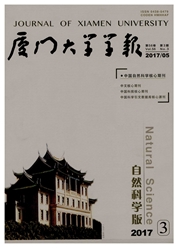

 中文摘要:
中文摘要:
CdSe是一种具有可见光响应的半导体材料,利用CdSe对TiO_2进行敏化有望使复合材料具有可见光吸收,有效促进光生电荷的分离.采用水热法在掺杂F的SnO2(FTO)导电玻璃表面制备金红石TiO_2纳米棒阵列,再采用连续离子层吸附反应法在TiO_2纳米棒阵列表面复合CdSe纳米颗粒,制得CdSe纳米颗粒敏化的TiO_2纳米棒阵列,并对其进行了表征.实验结果表明,CdSe纳米颗粒敏化的TiO_2纳米棒阵列在可见光区有较强的光吸收,其光电流密度是TiO_2纳米棒阵列的10倍,对亚甲基蓝的可见光催化降解速率较亚甲基蓝的自降解和TiO_2纳米棒阵列分别提高了85%和75%.
 英文摘要:
英文摘要:
CdSe is a kind of semiconductor materials with visible light response.Sensitizing TiO2 with CdSe can make composite ma-terial possessing visible light absorption and efficiently promote separation of photogenerated charges.In this work,TiO2 nanorod arrays were first synthesized on fluorine-doped tin oxide (FTO)with a hydrothermal method.CdSe nanoparticles were then deposited on TiO2 nanorod arrays by a successive ionic layer adsorption and reaction method.At last,CdSe nanoparticle sensitized TiO2 nanorod arrays were obtained and characterized.Experimental results showed that CdSe nanoparticle sensitized TiO2 nanorod arrays exhibited enhanced visible light absorption,and its photocurrent density was 10 times as high as that of pure TiO2 nanorod arrays.The photo-catalytic degradation rate of methylene blue over CdSe nanoparticle sensitized TiO2 nanorod arrays increased by 85% and 75%,sepa-rately compared to that of methylene blue self-degradation and pure TiO2 nanorod arrays.
 同期刊论文项目
同期刊论文项目
 同项目期刊论文
同项目期刊论文
 期刊信息
期刊信息
